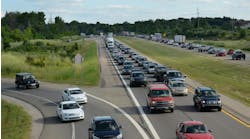Together for Safer Roads, an NGO dedicated to promoting road safety in collaboration with public and private sector partners, recently announced the findings from a study on its Truck of the Future pilot program, which works to enhance road safety for vulnerable road users in urban areas. The pilot, conducted throughout 2023, showcased promising results in utilizing innovative aftermarket technologies to mitigate potential conflicts between large fleet vehicles and VRUs.
Recent data underscores the urgent need for measures to protect VRUs: In 2021, 84% of the 7,388 pedestrian fatalities recorded occurred in urban areas, according to the Insurance Institute for Highway Safety. The ToF pilot program, a public-private partnership, sought to address this challenge by installing VRU detection systems on fleet vehicles, providing drivers with enhanced visibility and real-time feedback on potential near misses.
The VRU technology, developed by TSR member VisionTrack, utilizes AI-powered cameras to detect pedestrians, bicyclists, motorcyclists, and scooter users around the vehicle. Fleets participating in the pilot include the City of New York, with 10 vehicles each from two separate city departments, and AB InBev’s subsidiary in Mexico City, which had 10 vehicles participate in the pilot.
A total of 67,732 VRU alerts were recorded throughout the pilot program among the three participating fleets. Only VRUs detected within 0.8 meters of the vehicle were flagged to the driver. This volume of close proximity VRU alerts underscores the challenges faced by drivers on today’s roads and the importance of a technology that provides drivers with a 360-degree view of vision around the vehicle and alerts on imminent risks.
Key findings from the pilot program study include:
- Reduction in speeding: Installation of the VRU detection system was associated with a decrease in speeding over time, particularly in the most severe ‘red’ category and among outlier speeders. This finding was surprising as the system did not directly alert drivers when they were speeding. The reduction in speeding suggests the VRU detection system’s benefits may go beyond providing indirect vision and detection alerts to creating positive behavioral shifts among drivers toward safer practices.
- Increased VRU awareness: Drivers demonstrated greater awareness of VRUs over time. In one fleet, the proportion of VRU alerts that occurred while the driver was speeding decreased over time, suggesting that drivers consciously slowed down in areas where a VRU was likely to be detected. Meanwhile, a NYC department saw more alerts during warmer months, when more people were out, showing the system's importance in busy areas where the system would flag a VRU. AB InBev’s fleet saw an approximately 50% reduction in the number of VRU alerts over the first three months of the pilot, possibly due to changes in driver behavior. These results highlight how the system could help drivers be more aware and avoid incidents, making roads safer overall.
- Positive feedback:
- Both drivers and managers provided positive qualitative feedback on the effectiveness of the VRU detection system, highlighting its potential to prevent crashes and improve overall road safety. Nine out of 10 drivers surveyed thought the alerts would help prevent a crash.
- In a survey of managers/admin users post-pilot, both NYC (with a rating of 5 out of 5) and AB InBev managers (with a rating of 4.80 out of 5) felt that the cameras and alert systems helped make the roads safer.
"The findings from the Truck of the Future pilot program underscore the transformative potential of innovative technologies to make roads safer for Vulnerable Road Users and fleet vehicle drivers alike,” said Peter Goldwasser, executive director of Together for Safer Roads. “TSR remains committed to fostering cross-sector collaborations that prioritize the safety of all road users in ways that are actionable and scalable."



